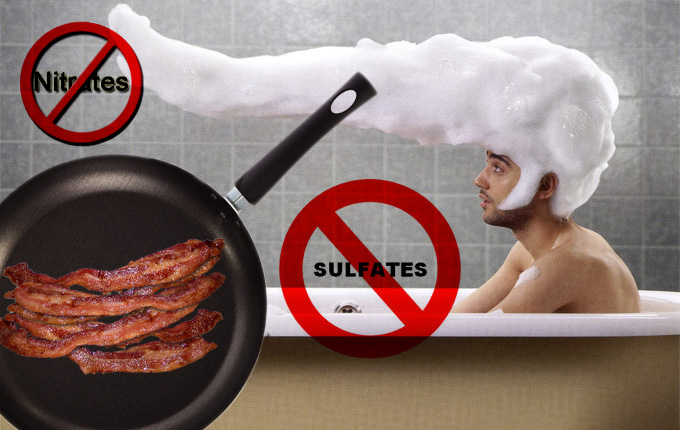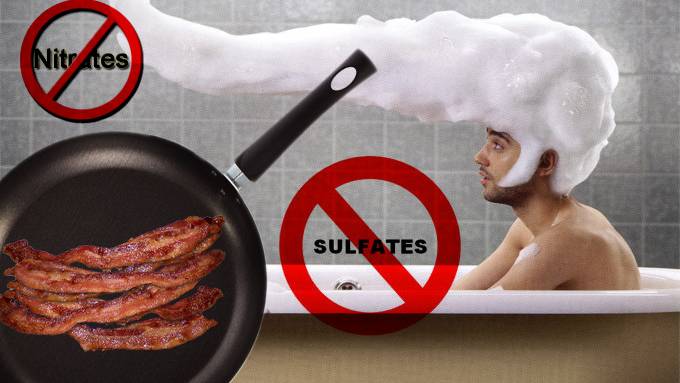Soapy Suds That Make You Dirty

Although, the health hazards of sulfates have been pointed out in other articles, it is worth re-visiting since products using sulfates continue to sell like fast food cheeseburgers. The message is not getting through. Are chemicals necessary in grooming and household products? Absolutely not. How important is it for you to have bubbly soap and shampoo? Are you willing to expose yourself to a known human carcinogen for foamy suds?
Sodium Lauryl Sulfate (SLS) and Sodium Laureth Sulfate (SLES) are commonly used in 90% of soaps, shampoos, conditioner, shower gels, shaving cream, facial cleansers, detergents, toothpastes, mouthwash, dish soap, cleaning products, cosmetics, lotions and other products that “foam” and “bubble.” Other common toxic sulfates used in products include Ammonium Lauryl Sulfate (ALS), Ammonium Lauryl Sulfate (ALS) and Sodium C14-16 Olefin Sulfate. Outside the U.S., they are often listed as sulfates. Their function is to surround dirt and oil, trapping and lifting it so they can be easily rinsed away. Therefore, they are also called surfactants or surface active agents. How “clean” are you when sulfates cause skin corrosion, eye deformities, protein denaturing, hormone imbalance, strip hair, create baldness and expose you to the potential of cancer due to the carcinogenicity?
SLS and SLES are esters of Sulphuric acid - SLS is also known as "Sulfuric acid monododecyl ester sodium salt," however there are over 150 different names by which it is known. SLES is commonly contaminated with dioxane, a known carcinogen and ethylene oxide. 1,4-dioxane is a byproduct of a petrochemical process called ethoxylation, which involves using ethylene oxide (a known breast carcinogen) to process other chemicals in order to make them less harsh. For example, sodium laurel sulfate, is often converted to the gentler chemical sodium laureth sulfate by processing it with ethylene oxide (the "eth" denotes ethoxylation), which can result in 1,4-dioxane contamination.
Ethylene oxide is a major industrial chemical and is one of the 25 chemicals of highest production volume in the United States. The National Institute for Occupational Safety and Health (NIOSH) posted an industry sponsored study on the health hazards of ethylene oxide (Et0). Et0 was associated with increases in leukemia in female rats and peritoneal mesotheliomas (malignant tumors) in male rats. There has been widespread recognition of the mutagenic potential of ethylene oxide, and recent evidence demonstrates adverse reproductive effects in mammals.
Ethylene oxide can also harm the nervous system and the California Environmental Protection Agency has classified it as a possible developmental toxicant based on evidence that it may interfere with human development. Additionally, it doesn’t easily degrade and can remain in the environment long after it is rinsed down the drain.
SLES cannot be metabolized by the liver and its effects are much longer-lasting. When you use these chemicals, the health risk this represents can be easily understood when several factors are taken into account: the rapid uptake and systemic penetration of SLS, the long-term tissue retention in the heart, liver, and brain, and the fact that the gums are one of the quickest ways to introduce substances into the bloodstream (SLS is in most toothpaste).
As with many chemicals, the companies that make these products, along with the FDA, argue that it’s "just a little bit." Therefore, in small doses it is not toxic. But one person may be exposed to large doses of chemicals since most of their personal products contain it. Over the course of day, these toxic exposures add up. Plenty of bogus articles can be found on the internet defending the “safety” of sulfates.
Another serious health concern with SLS is its tendency to react with other ingredients to form NDELA, a nitrosamine and potent carcinogen. According to a 1978 FDA report, shampooing the hair with a product contaminated with this nitrosamine can lead to its absorption into the body at levels much higher than eating nitrate-contaminated foods. Researchers actually estimate the nitrate absorption from one shampoo is equal to eating a pound of bacon!
Researchers have known for years that SLS is a skin irritant. In fact, SLS is used as a laboratory standard for irritating skin and inducing contact dermatitis. SLS is useful in laboratory testing "because of its ability to penetrate and impair the skin barrier. SLS damages skin barrier function, enhances allergic response to other toxins and allergens, damages and alters skin cells, causes substantial roughness in the skin and results in severe modification of skin recombinant structure.
SLS is implicated in premature hair loss in men and women, and may be one reason for widespread incidence of thinning hair. Because SLS is such a caustic cleanser, it actually corrodes the hair follicle and impairs its ability to grow hair. SLS is also implicated in scalp irritation, eczema, dandruff, and other scalp conditions. Many shampoos designed to alleviate dandruff, itching, and other scalp disorders may actually be causing the problems they are supposed to eliminate.
Don’t be fooled by “all natural” brands as many still contain sulfates. Read your labels! Alternatives do exist but not in your big box grocery stores. And don’t be fooled by fancy salon shampoos that say “green” because they still contain sulfates and parabens (chemical preservatives).
Another common ingredient in many beauty creams, cleansers, makeup, and other cosmetics is propylene glycol. This chemical is used in industry as anti-freeze, airplane de-icer, and brake fluid. Recent findings indicate that propylene glycol has severe adverse health effects, and has been found to cause contact dermatitis, ototoxicity, kidney damage, and liver abnormalities in various clinical human and animal studies.
Formaldehyde also contaminates personal care products when common preservatives release formaldehyde over time in the container. And BPA used to make containers also contaminates products.
Sulfates are also known to disrupt the endocrine system. The estrogen mimicking effects of SLS offers massive potential to cause cancer. It is known that many cancers, not least breast and ovarian cancer are directly related to estrogen levels; in fact some cancer cells actually secrete their own estrogen, which contributes to the growth of the tumor. Estrogen mimicking chemicals are also referred to as gender benders, which have been linked to not only cancer but infertility, endometriosis, genital deformities, erectile dysfunction, premature puberty, birth defects and gender confusion.
Bottom line sulfates are toxic to your body, to the environment and maim the animals that are used to test the products on. Need we say more?
More health articles






















